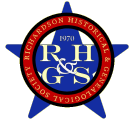
Return to HISTORY HOME PAGE

Return to HISTORY HOME PAGE
|
Richardson History Quick Facts If you are in a hurry, here are some "quick facts" about Richardson's history. Year Founded Richardson was founded in 1873 when the Houston & Texas Central Railroad, building north from Dallas to Denison, constructed a depot near the present-day intersection of East Main Street and Interurban Street. Namesake Richardson was named for the Secretary of the Houston & Texas Central Railroad, Alfred Stephen Richardson (not E. H. Richardson as the Texas Historical Commission marker at City Hall erroneously proclaims, nor George Richardson, as a 1950 newspaper article alleged.) Forerunner The forerunner of Richardson was a tiny settlement called Breckinridge in honor of U.S.Vice-President John C. Breckinridge, who unsuccessfully ran for President in 1860. Breckinridge was established in 1858 and abandoned sometime shortly after Richardson was founded in 1873. Today, a few trees alongside Abrams Road just before its intersection with Walnut Street (just north of Richland College) marks the site of the abandoned settlement. Oldest Surviving Residence The oldest surviving residence from early-day Richardson is the Skiles House at 813 Belt Line Road, just slightly more than a mile west of old downtown Richardson. Built in the late 1860s and surrounded by a white picket fence, it is still being used as a residence today. The next oldest it the Hill-Robberson House, a.k.a. "Miss Belle's Place." It was constructed in 1887 at 206 Sherman Street (near the corner of Polk and Sherman). After being donated to the City of Richardson in 1979, it was moved to Owens Spring Creek Farm, where it stood until 2021, when it was taken to its present temporary location at the Richardson Fire Dept. Training Center on Lookout Drive. The two-story house at 1030 W. Belt Line, surrounded by large trees, looks quite old too, but according to DCAD, it was built in 1920, but that was more than 100 years ago and before the city was incorporated. It is still a private residence. Oldest Surviving Commercial Buildings All the oldest surviving commercial buildings are located in the 100 block of East Main Street in old downtown Richardson. The oldest, reportedly built in 1888 (see Richardson Echo, December 9, 1938), is a tiny one-story rather ordinary looking building which was formerly Brack Lotheridge's cold drink stand. Lotheridge lived here too. It was remodeled in 1938 by Mayor Tom Jackson who had a brick wall built around the original frame building. (See Richardson Echo, Dec. 9, 1938.) Mayor Jackson used it as an office after remodeling. Presently occupied by a COVID19 Testing Service. The second oldest commercial building could be 101-103 E. Main, built in 1898 (or possibly earlier) and presently occupied by Collision Masters auto repair. It was originally Thompson's Dry Goods Store. Or it could be 111 E. Main, which was also constructed in 1898 as a combination grocery store and Odd Fellows Hall. The year "1924" at the top front of 111 E. Main is misleading. That's the year it was remodeled, not constructed. It is presently occupied by the Jasmine Hookah Lounge. The other old commercial buildings on this block are:
Almost all the other buildings on East Main between Texas Street and Greenville Avenue, and also alongside McKinney Street on either side of East Main, were constructed in the 1950s or 1960s. Interurban Interurban Street is named for the Interurban, a form of transportation that ran on electricity. Looking something like a cross between a streetcar and a railroad carriage, it started service in 1908 and lasted until 1948. It was operated by the Texas Traction Company (later the Texas Electric Railway Company) and connected Richardson with Dallas to the South and Denison to the north. The Interurban depot, built in 1909, stood where there is now a vacant Firestone Tire Store at the corner of E. Main and Interurban Street. It was demolished in 1966. The Interurban tracks (now gone) ran the length of Interurban Street. Incorporation The town of Richardson became the City of Richardson on June 27, 1925, when voters approved incorporation and elected Tom McKany the city's first mayor. Growth Stimulants Up until the middle of the twentieth century, Richardson was a small town that served the rural, cotton-growing community that surrounded it. Postwar growth and development was stimulated by a variety of factors, including: The building of U.S 75-Central Expressway, the arrival of large employers like Texas Instruments and Collins Radio, the postwar "baby boom," and the G. I. Bill which gave returning World War II veterans the chance to own a new home with no down payment. More recent stimulants to growth and development have been the arrival of modern high-tech and telecommunication firms and the DART light rail line that replaced the old H.&T.C./Southern Pacific tracks. A business-friendly city government has helped too.
This website copyright © 2023 (except where noted) by the Richardson Historical & Genealogical Society. All rights reserved. |